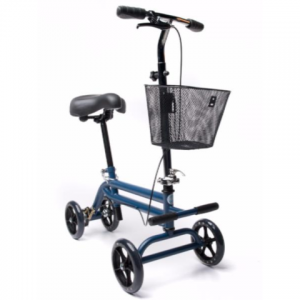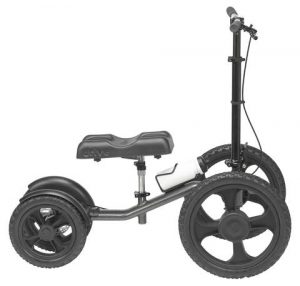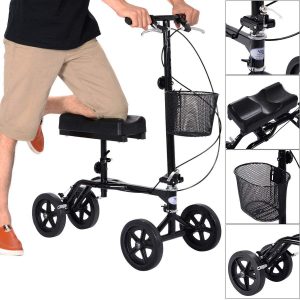Knee scooters (also called knee walkers or platform walkers) have provided an innovative alternative to crutches, canes and regular walkers. Scooters have allowed their users to move easier, safer, and with less pain than other mobility devices. To use a knee scooter, simply lock the hand brakes, grasp the handlebars, mount your injured leg onto the knee platform rest, unlock the brakes and begin to move using your unaffected leg to propel forward or backward–swivel handlebars provide for easy steering.
What is a knee scooter–what does it look like?
A knee scooter, or perhaps more commonly referred to as a knee walker, is a non-motorized device with wheels (usually 3-4), a resting platform for your knee, and handlebars. It is designed to allow its user to propel and move themself with their unaffected leg, while providing non-weight bearing rest for their affected (injured) leg. Therefore, the driver can steer themselves and go where they desire while resting their injured leg.


Different options, colors and designs exist for you to be able to pick the scooter most suited for your lifestyle. You can also personalize your scooters with optional accessories like baskets, knee rest cushions, bells, and cup holders. It is also possible to purchase scooters that come in very basic, simple designs.
What is a knee scooter used for?
Knee scooters are designed to increase mobility and safety for those who are struggling with an either permanently disabled or temporarily injured foot or ankle and find it hard or impossible to bear any weight on that side. It aids a person in waiting for surgery or recovery by allowing them to keep doing daily activities.
Knee scooters allow people to move about without the pain and discomfort of using crutches.
When using crutches most of your body weight rests in your arms–with a knee scooter, you use your leg muscles to move while providing your injured leg non-weight bearing rest.
Similarly, knee scooters allow their users to be hands free. Imagine being able to stand, rest your injured leg, and cook a meal–the knee scooter allows for that.
Step by step: How to knee scooter

- Make sure that the hand brakes are locked so that the scooter remains stationary.
- Place both hands on the handle bars.
- Mount your affected (injured) leg onto the knee platform. Keep your unaffected leg on the ground next to the scooter.
- Ensure that you are stable and balanced.
- Unlock the hand brakes.
- Use your ground leg to push yourself and the scooter forward or backward.
- When wanting to stop, apply weight with your unaffected leg onto the ground and use it to stop yourself–do not attempt to stop using the hand brakes.
- Once stopped, lock the hand brakes so that the scooter remains stationary.
- Keep your hands on the handlebars as you step off of the scooter.
When might a knee scooter be helpful?
If you are struggling with mobility as a result of a temporary or permanent foot or ankle injury, or are recovering from surgery to a foot or ankle, a knee scooter may be a good option for you.
The following list may be helpful to you as you think about your need for a knee scooter:
- Before an ankle surgery
- Recovery from an ankle surgery
- While recovering from an ankle injury (sprain, strain or fracture)
- While recovering from foot ulcer or wound (common in persons with Diabetes), or waiting for surgery
- Recovery from torn or inflamed Achilles tendon
- Before an amputation to leg or foot
- If you have a permanently disabled leg, foot, or ankle
- If you are elderly and have difficulty walking due to foot or ankle pain, stiffness or discomfort on one side
Who should not use a knee scooter?
Knee scooter (walker) use is NOT recommended–
- if you have had knee or hip surgery. This device is designed for injury to the lower extremity–foot or ankle. If you think you could benefit from one and have had knee or hip surgery make sure you ask your doctor first!
- if both feet or ankles are injured. The knee scooter is designed for you to use your unaffected (strong and healthy) side to give your affected (injured) side a break.
- if balance, coordination, and/or vision is an issue for you. You need to be able to balance and steer the scooter safely.
- if you are under the influence of drugs or alcohol. Anything that alters your ability to be safe, balanced and coordinated should not be used while driving a knee scooter.
How will I pay for a knee scooter?
Many medical equipment devices can be covered by insurance either fully or partially with a physician’s prescription note. When you look into buying or renting your knee scooter, check with your doctor, your insurance company, and the medical supply company to ensure that you have all the required information and documents to have your scooter covered (fully or partially) by insurance.
Tips for choosing the best knee scooter
Think about where you go on a regular basis (daily, weekly, monthly…) and what type of terrain you encounter.
- Are there gravel walkways or unpaved parking lots?
- Do you have to walk through grass or dirt? Thick carpet?
- What is the weather like–snow, ice, rain, mud?
Thinking through these kinds of questions can help you select the best knee scooter for you.
A “standard” scooter model works well for people who just need a knee scooter to help them get around inside the house. Its smaller size and frame make it easy to maneuver around corners, in hallways and into small spaces (like bathrooms).
For adventurous people who like to be outside and uninhibited by gravel or dirt, an “all terrain” scooter model may be the best fit. This model of knee scooter was designed to be able to access grass, gravel, dirt, and even icy surfaces. The “all terrain” scooter has larger wheels with more tread to help get through tougher surfaces.
Pediatric scooters are also available for individuals less than 5’5” (children or adults). They include the same features as standard models but are size appropriate for smaller people.
It is highly recommended that you talk with your primary care physician about the best option for you before purchasing a knee scooter, they can help you select and determine an appropriate size and model.
Where can a knee scooter be purchased?
Know your options and take your time looking for the best knee scooter to fit your needs. Talk with your doctor or other people who have used one, read reviews and do your research.
This supplier called CSA Medical Supply has knee scooters ranging from about $140-$400.
This site called Vive Health has a selection of different medical equipment as well. You can search for accessories like cup holders, baskets, bells and knee pads for your knee scooter. This site also provides some helpful purchase information and comparisons of costs between buying new or used and renting.
Of course Amazon also offers a variety of knee scooter options.
Important safety tips and things to keep in mind:
As a general rule, the biggest safety concern with a knee scooter is falling. Falls are a big safety hazard, especially with elderly people. Read through the following tips before using a scooter. And, if you are helping a child or senior learn to use a knee scooter, please read these tips with them and help them to understand.
- Before use, make sure that the height is appropriately adjusted.
- Make sure that pins, nuts and bolts, and clamps are securely fastened before each use.
- Do not attempt to descend or climb stairs, steps, or escalators of any kind with your knee scooter. Do not go near stairs.
- Do not try to reach down or to the side while on your knee scooter as this can result in falls.
- Try to maintain all wheels on the ground at all times, maintain balance in the center.
- Do not attempt to stop the scooter with the hand brakes–always use your unaffected foot to come to a stop and then set the hand brakes to put the scooter in a stationary position.
- Always maintain both hands on the handlebars while in motion. If your lifestyle requires you to carry things (books, a drink, a phone, a purse, etcetera) purchase a basket or cup holder for your scooter.
- Do not carry a baby or other person while on your scooter.
- Wear non-slip shoes while using the knee scooter.
- Use caution when transferring to a different surface (example: going from tile floor to carpet or going from a parking lot to a side walk).
- Do not pull yourself up from a seated position using the scooter, this could result in a fall.
- Do not try to go fast or turn sharply.
Remember, safety first!